Short Chain versus Long Chain Omega-3 Fatty Acids: EPA, DHA, ALA and the Difference

Omega-3 goes by many names, including fish oil, essential fatty acids, and poly-unsaturated fatty acids (PUFA’s). To take it one step further, there are two types of omega-3s, long-chain and short-chain fatty acids. However, there are key differences between the two and how the human body uses them.

Short-Chain ALA (alpha-linolenic acid) differences from long-chain fatty acids
Short-chain fatty acids are found in plant sources like flax, chia, hemp, canola oil, and walnuts. Through digestion, ALA can be converted into long-chain fatty acids for the body to use. However, the conversion is typically somewhere between 6 and 10 percent and is considered inefficient.

Advanced Omega-3 Supplement
Advanced Omega 3 Supplement contains 720 mg EPA, 480 mg DHA, and 200 mg other omega-3 fatty acids in each serving of two lemon-flavored softgels. Omega 3 supplementation supports heart health, cognition, immune, and inflammatory health without any fishy aftertaste.†
$22.98 Add to cartOverall, research on ALA has been mixed. While omega-3 consumption has been linked with improving the body’s ability to reduce the risk of cardiac events, this mostly has been focused on long-chain fatty acids like EPA and DHA.
Diets similar to Mediterranean-style diets have been shown to improve heart health related to the increase in overall omega-3 consumption. But again, these diets offer mixed sources of short-chain and long-chain fatty acids in the recommended foods.
One area of concern for those looking to add healthy oils is that light, heat, and air can destroy the beneficial short-chain fatty acids ALA can provide. Specifically, the American Heart Association (AHA) points out that deep frying foods is never a recommended method for cooking with vegetable oil. The AHA also points out that “any oil starts to degrade once it reaches its smoke point,” so any cooking oil should not be used if it starts to smoke.
Long-Chain Fatty Acids (EPA and DHA) and their health benefits
Eicosapentaenoic acid and docosahexaenoic acid are long-chain fatty acids more commonly known as EPA and DHA. Long-chain fatty acids differ from short-chain fatty acids due to a longer structural makeup. EPA and DHA are important nutrients that aid the development of the body and are only obtained from food.
In cognitive development, DHA stands since it is the most abundant fatty acid found in brain tissue. Long-chain fatty acid deficiency of DHA can increase the risk of some neurocognitive disorders and impair learning and memory development. For heart health, increasing long-chain fatty acid levels has been shown to reduce triglyceride levels. High levels of EPA and DHA have also been linked with a lower risk of developing age-related macular degeneration or AMD.
Another difference between short and long-chain fatty acids is the food that contains them. Long-chain fatty acids are found in sources such as fatty fish like salmon, herring, and trout or taking fish oil (omega-3) supplements. A recent study also demonstrated the ability of curcumin to help absorb EPA and DHA throughout the body. Both curcumin from turmeric and long-chain fatty acids have been shown to reduce markers of inflammation throughout the body.
Remember, it’s important to talk with your physician before starting a new supplement regimen.
